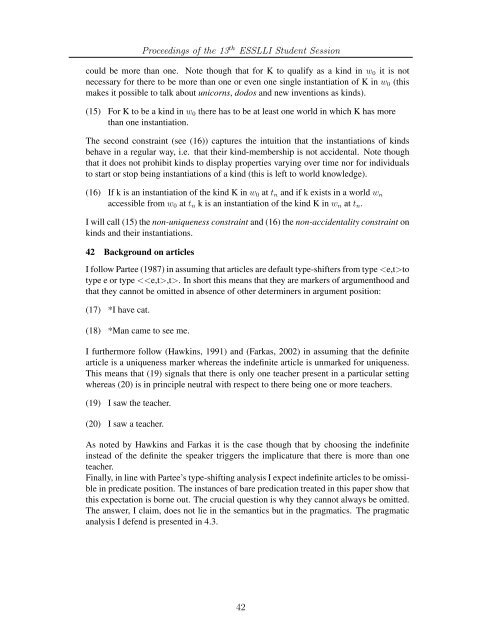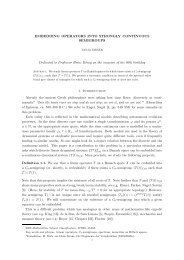Proceedings of the 13 ESSLLI Student Session - Multiple Choices ...
Proceedings of the 13 ESSLLI Student Session - Multiple Choices ...
Proceedings of the 13 ESSLLI Student Session - Multiple Choices ...
You also want an ePaper? Increase the reach of your titles
YUMPU automatically turns print PDFs into web optimized ePapers that Google loves.
could be more than one. Note though that for K to qualify as a kind in w0 it is not<br />
necessary for <strong>the</strong>re to be more than one or even one single instantiation <strong>of</strong> K in w0 (this<br />
makes it possible to talk about unicorns, dodos and new inventions as kinds).<br />
(15) For K to be a kind in w0 <strong>the</strong>re has to be at least one world in which K has more<br />
than one instantiation.<br />
The second constraint (see (16)) captures <strong>the</strong> intuition that <strong>the</strong> instantiations <strong>of</strong> kinds<br />
behave in a regular way, i.e. that <strong>the</strong>ir kind-membership is not accidental. Note though<br />
that it does not prohibit kinds to display properties varying over time nor for individuals<br />
to start or stop being instantiations <strong>of</strong> a kind (this is left to world knowledge).<br />
(16) If k is an instantiation <strong>of</strong> <strong>the</strong> kind K in w0 at tn and if k exists in a world wn<br />
accessible from w0 at tn k is an instantiation <strong>of</strong> <strong>the</strong> kind K in wn at tn.<br />
I will call (15) <strong>the</strong> non-uniqueness constraint and (16) <strong>the</strong> non-accidentality constraint on<br />
kinds and <strong>the</strong>ir instantiations.<br />
42 Background on articles<br />
I follow Partee (1987) in assuming that articles are default type-shifters from type to<br />
type e or type . In short this means that <strong>the</strong>y are markers <strong>of</strong> argumenthood and<br />
that <strong>the</strong>y cannot be omitted in absence <strong>of</strong> o<strong>the</strong>r determiners in argument position:<br />
(17) *I have cat.<br />
(18) *Man came to see me.<br />
I fur<strong>the</strong>rmore follow (Hawkins, 1991) and (Farkas, 2002) in assuming that <strong>the</strong> definite<br />
article is a uniqueness marker whereas <strong>the</strong> indefinite article is unmarked for uniqueness.<br />
This means that (19) signals that <strong>the</strong>re is only one teacher present in a particular setting<br />
whereas (20) is in principle neutral with respect to <strong>the</strong>re being one or more teachers.<br />
(19) I saw <strong>the</strong> teacher.<br />
(20) I saw a teacher.<br />
<strong>Proceedings</strong> <strong>of</strong> <strong>the</strong> <strong>13</strong> th <strong>ESSLLI</strong> <strong>Student</strong> <strong>Session</strong><br />
As noted by Hawkins and Farkas it is <strong>the</strong> case though that by choosing <strong>the</strong> indefinite<br />
instead <strong>of</strong> <strong>the</strong> definite <strong>the</strong> speaker triggers <strong>the</strong> implicature that <strong>the</strong>re is more than one<br />
teacher.<br />
Finally, in line with Partee’s type-shifting analysis I expect indefinite articles to be omissible<br />
in predicate position. The instances <strong>of</strong> bare predication treated in this paper show that<br />
this expectation is borne out. The crucial question is why <strong>the</strong>y cannot always be omitted.<br />
The answer, I claim, does not lie in <strong>the</strong> semantics but in <strong>the</strong> pragmatics. The pragmatic<br />
analysis I defend is presented in 4.3.<br />
42

















